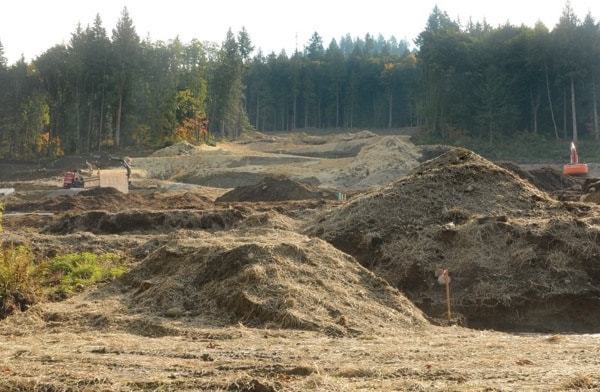Steps are being taken to seal up the Grant Hill Estates subdivision site on Bosonworth Avenue, following a District of Maple Ridge stop-work order intended to prevent erosion on the site.
The district issued the order Oct. 6 at the location where 106 one-acre homes are being built on the north side of Grant Hill, near 252nd Street.
“It basically stops any further clearing and moving into new areas until the erosion protection measures are addressed,” public works manager Frank Quinn said Wednesday.
Those measures include enlarging the capacity of the sedimentation ponds that collect silty water before it’s released to streams. Other measures include spreading straw on the hillside to prevent erosion, improving the rock armouring of streams and collection points and installing pipes to direct run off to existing storm sewers.
“We’ll have to wait for the next rainfall evesnt to see how those measures hold up,” Quinn explained.
The order was issued after sediment entered Kanaka Creek from an unnamed tributary. Quinn didn’t have readings of sediments available, but said it was “enough to cause them concern.”
Ross Davies, with Kanaka Education and Environmental Partnership Society, is monitoring the area in cooperation with Fisheries and Oceans Canada.
He was pleased with the district issuing the order, but added that the release of sediment was “probably not a great deal on its own.”
He said one turbidity reading was 202 compared to a normal measure of 75, and pointed out readings hit the 20,000’s in Spencer Creek when homes were being built there a few years ago.
“It’s not something that’s going to kill fish.” But if it went on for any length of time, insect production could be lost, he added.
The site has since been improved, but “It’s pretty simple, they cleared too much land, too quickly,” Davies said.
Developer Paul Hayes pointed out that sediment-control measures worked fine all last winter.
“What we continue to do – is measure to control water,” Hayes said last week.
“I’ve done this for a long time and it’s important to me as a member of the community to do things right.”
He pointed out his company’s environmental monitor first issued the order and the district just repeated it.
“In the meantime, we continue to do environmental sediment control measures on site. We’re just preparing for the rain.”
Work, though, all depends on the weather conditions. “Whenever it didn’t permit it, we didn’t do it.”
He added he relied on the experts. “We’re paying attention.”
“We’ve started the project. We want to finish the project.”
Coun. Craig Speirs was worried about the winter weather and possible increases in erosion from heavy rain.
“Just wait until we get the torrential downpours that we know are coming.”
“It seems kind of predictable, when you take all the trees and roots off a hillside, that it’s going to wash into the creek,” he added at Monday’s council workshop.
He still disagrees with the subdivision of large rural properties into one-acre lots that is currently allowed by Maple Ridge’s official community plan, considering it sprawl.
Hayes said one of the reasons sections were cleared was because of construction of a water supply system across the site, which couldn’t be done in phases.
But doing a project in stages, “ideally, that’s what a developer wants to do.”
Quinn pointed out that the entire site hasn’t been cleared, and that the developer “has been very cooperative and working together with us and the senior agencies to address the concerns that are out there.
“They did stop the work immediately. They have been very cooperative in trying to address this issue.”
The development will feature an on-site tertiary sewage treatment system that will collect sewage from each residence and treat it on site to Canadian Drinking Water standards before release to a dispersal field.
